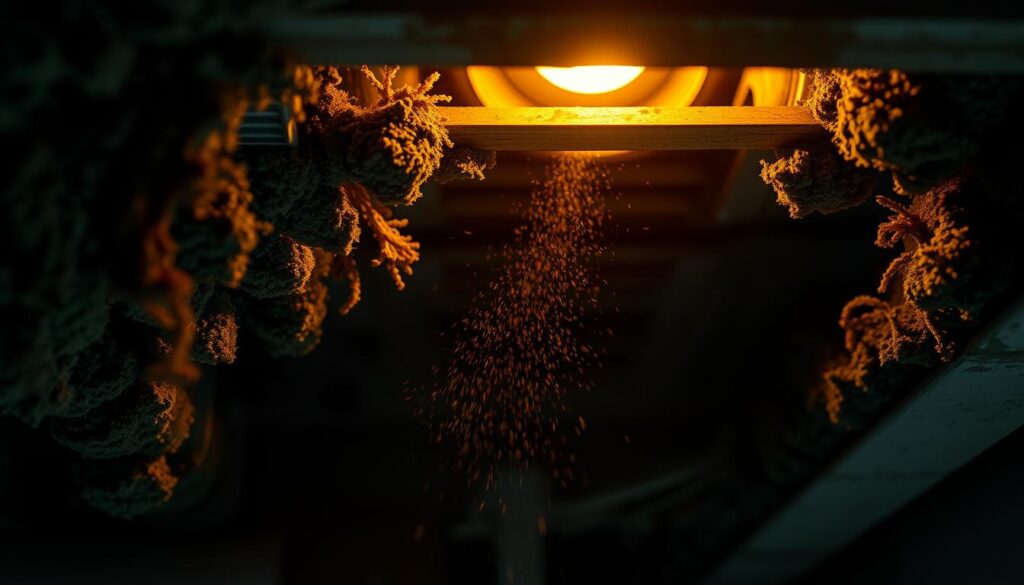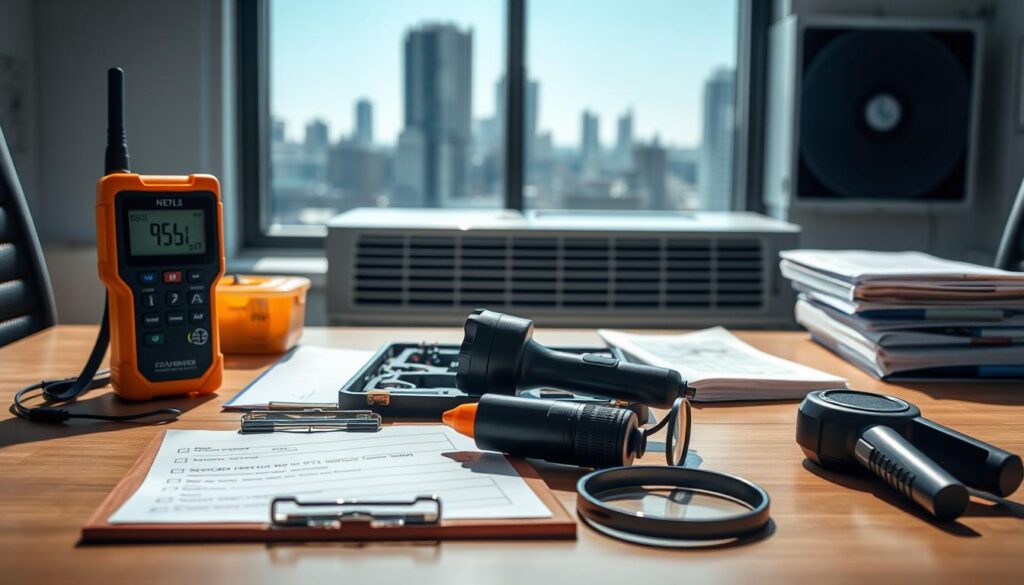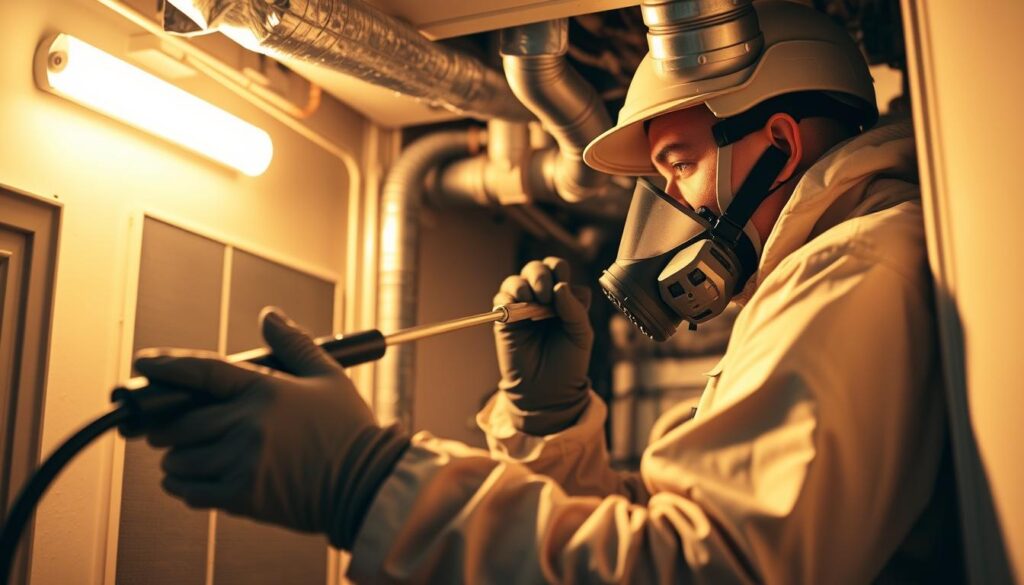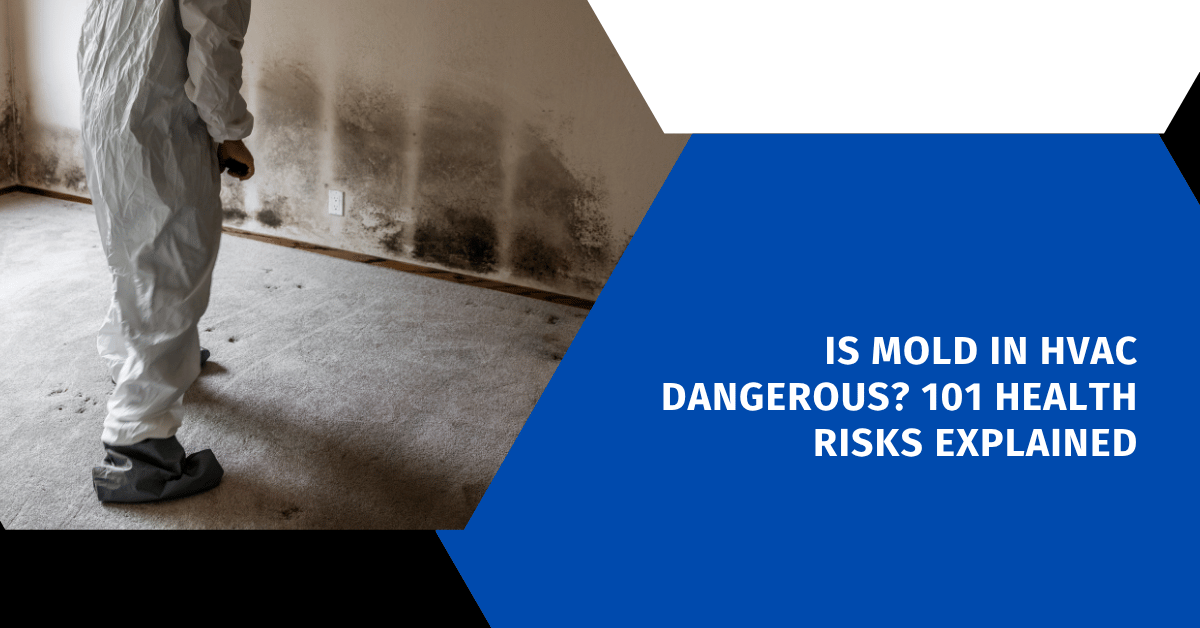Affiliate Disclosure
HVAC Guide Guys is a participant in the Amazon Services LLC Associates Program, an affiliate advertising program designed to provide a means for sites to earn advertising fees by advertising and linking to Amazon.
Is Mold in HVAC Dangerous? Did you know your air conditioning system could be silently harming your family’s health? Recent findings in the HVAC industry have uncovered a shocking truth about mold in air conditioning systems. Every homeowner needs to know about this.

The recall of 1.7 million Midea air conditioning units due to mold buildup has raised a big question: Is mold in HVAC dangerous? This hidden danger hides in cooling systems meant to keep you comfortable. It can turn your home’s air quality into a serious health risk.
Mold in HVAC systems is more than just a cosmetic issue. It can cause respiratory infections, allergic reactions, persistent coughing, and sore throats. Your cooling system might be spreading tiny spores that harm your indoor air.
Key Takeaways
- HVAC systems can become breeding grounds for dangerous mold
- Mold growth poses significant health risks to household members
- Regular HVAC maintenance is key to preventing mold buildup
- Certain populations are more vulnerable to mold-related health issues
- Professional inspection can help detect early signs of mold infestation
Table of Contents
Understanding HVAC Mold: A Hidden Health Threat
Your home’s HVAC system can be a breeding ground for dangerous mold. Black mold in air ducts poses a silent but serious health risk. The complex environment inside your HVAC system is perfect for toxic mold to thrive.
Mold needs moisture, organic material, and darkness to grow. Your HVAC system naturally provides these conditions. This makes it an ideal habitat for mold to develop.
Types of Mold in HVAC Systems
- Aspergillus – common in air conditioning units
- Stachybotrys (black mold) – most dangerous variety
- Penicillium – frequently found in cool, damp environments
- Alternaria – thrives in humid air conditioning systems
Why HVAC Systems Become Mold Havens
Air conditioning systems create moisture through condensation. Drain pans, condensate lines, and evaporator coils collect water. This creates a perfect breeding ground for mold.
| HVAC Mold Growth Areas | Moisture Level | Mold Risk |
|---|---|---|
| Drain Pans | High | Extreme |
| Condensate Lines | Constant | High |
| Air Ducts | Moderate | Moderate |
Common Mold Development Locations
Black mold in air ducts typically grows in:
- Dark, enclosed ductwork
- Behind air vents
- Near cooling coils
- Surrounding air filters
Regular maintenance and professional inspections can help prevent dangerous mold growth in your HVAC system.
Is Mold in HVAC Dangerous: Key Health Risks and Concerns
Mold in your HVAC system can be very dangerous. It can cause health problems that go beyond just feeling uncomfortable. When mold spores spread through your air conditioning, they can lead to respiratory issues.
These respiratory problems can be serious:
- Persistent coughing and wheezing
- Nasal congestion and sinus irritation
- Recurring sore throats
- Itchy or watery eyes
- Skin rashes or irritation
Some people are more at risk. Children, elderly individuals, and people with pre-existing respiratory conditions may have worse reactions to mold spores.
Mold in your HVAC system can be a constant threat to your health. It turns your HVAC system into a place where respiratory problems can grow. Mold spores spread through your home with each air cycle.
The EPA warns that indoor air can be 2-5 times more polluted than outdoor air, with HVAC mold being a significant contributor to this problem.
It’s important to know about these risks to keep your family safe. Regular HVAC checks and quick mold detection can help prevent respiratory problems. This ensures a healthier home for everyone.
Explore Our HVAC Shop
Looking for top-rated HVAC tools, parts, and accessories? Visit our shop and find the perfect solution for your needs.
Visit the ShopIdentifying Signs of Mold Infestation in Your HVAC System
Finding mold in your HVAC system early can stop serious health problems and expensive fixes. Mold in indoor air can quietly spread through your home’s air, posing risks to you and your family.
It’s key to spot the signs of hvac mold symptoms to keep your home healthy. Your HVAC system can hide mold in many places. So, finding it early is very important.
Visual Indicators of Mold Growth
- Dark or discolored spots around air vents
- Visible green, black, or white fuzzy patches on filters
- Unusual staining on ductwork or evaporator coils
- Persistent moisture or water droplets inside system components
Unusual Odors and System Performance Issues
Your HVAC system might show mold presence through small changes. Musty, earthy smells when it runs could mean mold is hiding. Look out for these signs:
- Reduced airflow from vents
- Unexplained increase in energy bills
- Inconsistent cooling or heating
- Strange noises during system operation
Health Symptoms That Signal HVAC Mold
Notice any physical reactions that might be linked to mold from your air conditioning. Possible hvac mold symptoms include:
- Persistent respiratory irritation
- Unexplained allergic reactions
- Frequent headaches
- Increased asthma or breathing difficulties
Spotting mold in your HVAC system early can keep you healthy and avoid big damage to your home’s air quality.
Health Impact of Mold Exposure Through Air Conditioning
Mold in air conditioning systems can cause serious health problems. Many homeowners don’t realize the dangers. The health risks of mold in air conditioning go beyond just feeling uncomfortable. They can lead to serious respiratory issues from HVAC mold, affecting your health greatly.
Mold spores in your HVAC system can cause many health issues. These problems can be immediate or long-term:
- Respiratory irritation and breathing difficulties
- Increased allergy symptoms
- Persistent coughing and wheezing
- Sinus congestion
- Potential development of asthma-like symptoms
Vulnerable individuals like children, the elderly, and those with breathing problems are at higher risk. Long-term exposure to HVAC mold can lead to serious health issues. These include lung infections and weakened immune systems.
It’s important to know the signs of mold-related health problems. If you have unexplained breathing issues that get worse when your air conditioning is on, it might be mold. Getting a professional to check and fix the problem can protect your health and prevent more issues.
Early detection and proactive management of HVAC mold can significantly reduce health risks and improve indoor air quality.
Explore Our HVAC Shop
Looking for top-rated HVAC tools, parts, and accessories? Visit our shop and find the perfect solution for your needs.
Visit the ShopVulnerable Populations at Higher Risk from HVAC Mold
Mold in air conditioning systems can be harmful, affecting some groups more than others. It’s important to know who is at risk to protect them from respiratory problems caused by HVAC mold.
Not everyone reacts the same to mold. Some groups are more at risk and need extra care and awareness.
Children: Developing Immune Systems at Risk
Young children’s immune systems are not fully developed. This makes them more likely to get sick from mold. Their lungs are also more sensitive, leading to:
- More respiratory infections
- A higher chance of getting asthma
- Possible long-term lung problems
Elderly Individuals: Compromised Health Defenses
Older adults have a harder time fighting off mold because of:
- Weaker immune systems
- Existing lung problems
- Less ability to fight off lung infections
Individuals with Respiratory Conditions
People with lung problems are at a higher risk from mold. Those with asthma, allergies, or chronic lung diseases may face:
| Condition | Potential Mold Exposure Consequences |
|---|---|
| Asthma | More frequent attacks |
| Allergies | Severe allergic reactions |
| Chronic Lung Disease | Worse lung problems |
Immunocompromised Individuals
Those with weakened immune systems are at a high risk from HVAC mold. Patients on chemotherapy, organ transplant recipients, and people with HIV/AIDS are most at risk of serious health problems from mold.
Regular HVAC checks and maintenance are key to keeping these groups safe from mold-related health issues.
Professional HVAC Mold Testing and Inspection

When it comes to cleaning your HVAC system and dealing with indoor air quality mold, professional testing is key. DIY methods often can’t find hidden mold. This can harm your home’s air quality and your family’s health.
Professional mold inspectors use top-notch equipment to find even the toughest mold infestations. Their tools give a detailed look that goes beyond just looking at the surface.
- Infrared cameras detect moisture behind walls
- Moisture meters identify hidden dampness
- Calibrated air sampling equipment measures mold spore concentrations
- Advanced diagnostic tools pinpoint possible mold growth areas
The inspection process includes several important steps:
- Comprehensive visual examination of your HVAC system
- Detailed air quality testing
- Moisture level assessment
- Collection of samples for laboratory analysis
Professional mold testing offers a scientific way to understand your indoor air quality problems. Experts can spot specific mold types, figure out how bad the contamination is, and suggest the best ways to fix it. This helps keep your home safe and healthy.
Investing in professional HVAC mold testing is a vital step in keeping your living space safe and healthy.
Explore Our HVAC Shop
Looking for top-rated HVAC tools, parts, and accessories? Visit our shop and find the perfect solution for your needs.
Visit the ShopEffective Mold Prevention Strategies for HVAC Systems
To keep your home mold-free, you need to clean and maintain your HVAC system well. Understanding how to prevent mold in HVAC systems is key to keeping your air clean and your health safe.
Mold loves damp, dark places, making your HVAC system a perfect spot for it to grow. By using the right prevention methods, you can lower the chance of mold taking over.
Maintenance Schedule Requirements
Having a good maintenance plan is vital to stop mold from growing. Your HVAC system needs regular care to stay clean and work well:
- Schedule professional inspections annually
- Clean air ducts every 3-5 years
- Check for water leaks or condensation monthly
Humidity Control Methods
Keeping the humidity in your home right is key to stopping mold in HVAC systems. Try to keep humidity levels between 30-50% with these methods:
- Use dehumidifiers in moisture-prone areas
- Ensure proper ventilation
- Install humidity monitors
Filter Selection and Replacement
Picking the right air filters is important for keeping your HVAC system clean:
| MERV Rating | Filtration Capability | Replacement Frequency |
|---|---|---|
| 1-4 | Basic filtration | Every 3 months |
| 5-8 | Better particle capture | Every 2 months |
| 9-12 | High-efficiency filtration | Every 1-2 months |
Pro tip: Higher MERV ratings catch more mold spores, giving your home’s air quality a big boost.
HVAC Mold Remediation Process and Solutions

Mold in your HVAC system needs a careful and detailed plan. Removing mold from air conditioners is not easy to do yourself. Professional cleaning involves several important steps to remove mold completely and stop it from coming back.
The mold remediation process includes several key stages:
- Initial system inspection and assessment
- Containment of affected areas
- Removal of contaminated components
- Deep cleaning and sanitization
- Moisture source identification
Professional technicians use special tools for thorough mold removal. High-efficiency vacuum systems and antimicrobial treatments are key to getting rid of mold spores. They know that just cleaning visible mold isn’t enough. They must also fix the moisture problems that let mold grow.
In some cases, you might need to replace parts of your HVAC system. This could include ductwork, insulation, or filters. After the cleaning, tests are done to make sure your system is mold-free.
Remember: Effective HVAC system cleaning goes beyond surface treatment – it’s about creating a long-term solution to protect your indoor air quality.
Getting professional mold remediation helps keep your home’s air clean and your family healthy. Regular checks and quick action from experts are essential to keep your HVAC system clean and free of mold.
Explore Our HVAC Shop
Looking for top-rated HVAC tools, parts, and accessories? Visit our shop and find the perfect solution for your needs.
Visit the ShopLong-term Protection: Maintaining a Mold-Free HVAC System
To keep your HVAC system mold-free, you need a solid plan. This plan should include regular maintenance and steps to prevent mold. It’s important for your system’s health and your well-being.
Stopping mold in HVAC systems is a big job. It starts with these key steps:
- Schedule professional HVAC inspections twice annually
- Replace air filters every 90 days
- Monitor indoor humidity levels
- Address water leaks immediately
- Ensure proper ventilation throughout your home
Get air filters that catch tiny mold spores. HEPA filters and UV light purification systems are great for this. They keep your air clean and stop mold from growing.
Keeping your home safe from HVAC mold is a big job. You need to keep up with maintenance, fix things fast, and upgrade when needed. This way, you’ll make your home healthier for your family.
“Prevention is always more effective than remediation when it comes to indoor air quality and mold control.”
Conclusion
Understanding if mold in HVAC systems is dangerous is key. It shows important health risks that need quick action. Your indoor air quality affects your family’s health, making it vital to manage mold well.
Mold in air conditioning can cause mild breathing issues or serious allergies and lung problems. Getting a professional to check your system and keeping it clean is your best defense. By being careful and using good prevention, you can lower the chance of mold in your HVAC.
Acting fast can stop long-term health problems and save you money on repairs. Get a pro to check your HVAC, keep humidity right, and change filters often. Remember, mold in HVAC is dangerous. Keeping your system clean protects your family’s health and your equipment.
Invest in your home’s air quality today. Being proactive with HVAC care is the best way to keep your home healthy and comfy for you and your family.
FAQ
How dangerous is mold in my HVAC system?
What are the most common signs of mold in my air conditioning system?
Can I remove HVAC mold myself, or do I need professional help?
How can I prevent mold growth in my HVAC system?
Who is most at risk from HVAC mold exposure?
How often should I have my HVAC system professionally inspected for mold?
What health symptoms might indicate mold exposure from my HVAC system?
Can black mold in my HVAC system be particular dangerous?
What are the long-term consequences of untreated HVAC mold?
How much does professional HVAC mold remediation typically cost?
How dangerous is mold in my HVAC system?
What are the most common signs of mold in my air conditioning system?
Can I remove HVAC mold myself, or do I need professional help?
How can I prevent mold growth in my HVAC system?
Who is most at risk from HVAC mold exposure?
How often should I have my HVAC system professionally inspected for mold?
What health symptoms might indicate mold exposure from my HVAC system?
Can black mold in my HVAC system be particular dangerous?
What are the long-term consequences of untreated HVAC mold?
How much does professional HVAC mold remediation typically cost?
FAQ
How dangerous is mold in my HVAC system?
Mold in your HVAC system is very dangerous. It can cause serious health problems like breathing issues and allergies. It can also lead to long-term health issues, mainly for kids, the elderly, and those with breathing problems.
What are the most common signs of mold in my air conditioning system?
Look for signs like discoloration around vents and visible mold on parts. Musty smells and unexplained breathing problems are also signs. Unusual dust or constant allergies could mean mold in your HVAC system.
Can I remove HVAC mold myself, or do I need professional help?
You might be able to handle small mold issues yourself. But for big problems, you should get a pro. They have special tools and know-how to find and remove mold. DIY methods often miss the root cause of mold.
How can I prevent mold growth in my HVAC system?
Keep humidity low and change air filters often. Get your HVAC checked by a pro every year. Fix water leaks fast and ensure good ventilation. Clean the outdoor unit area and use a dehumidifier to lower mold risk.
Who is most at risk from HVAC mold exposure?
Kids, the elderly, and those with breathing issues are most at risk. They can face serious health problems from mold spores in HVAC systems.
How often should I have my HVAC system professionally inspected for mold?
Get your HVAC checked by a pro at least once a year. Do it before the busy cooling or heating season. If you live in a humid area or notice mold signs, check more often.
What health symptoms might indicate mold exposure from my HVAC system?
Look out for coughing, wheezing, and nasal problems. Skin rashes, headaches, and fatigue can also be signs. If these get worse when your HVAC is on, it might be mold.
Can black mold in my HVAC system be particular dangerous?
Yes, black mold is very dangerous. It can cause serious breathing and brain problems. It grows in damp places and needs quick professional help to avoid health risks.
What are the long-term consequences of untreated HVAC mold?
Untreated mold can cause chronic breathing problems and infections. It can damage lungs and worsen allergies and asthma. Long-term exposure can lead to serious health issues.
How much does professional HVAC mold remediation typically cost?
The cost varies based on the mold amount. It can be from 0 to ,000. Small issues might cost 0-
FAQ
How dangerous is mold in my HVAC system?
Mold in your HVAC system is very dangerous. It can cause serious health problems like breathing issues and allergies. It can also lead to long-term health issues, mainly for kids, the elderly, and those with breathing problems.
What are the most common signs of mold in my air conditioning system?
Look for signs like discoloration around vents and visible mold on parts. Musty smells and unexplained breathing problems are also signs. Unusual dust or constant allergies could mean mold in your HVAC system.
Can I remove HVAC mold myself, or do I need professional help?
You might be able to handle small mold issues yourself. But for big problems, you should get a pro. They have special tools and know-how to find and remove mold. DIY methods often miss the root cause of mold.
How can I prevent mold growth in my HVAC system?
Keep humidity low and change air filters often. Get your HVAC checked by a pro every year. Fix water leaks fast and ensure good ventilation. Clean the outdoor unit area and use a dehumidifier to lower mold risk.
Who is most at risk from HVAC mold exposure?
Kids, the elderly, and those with breathing issues are most at risk. They can face serious health problems from mold spores in HVAC systems.
How often should I have my HVAC system professionally inspected for mold?
Get your HVAC checked by a pro at least once a year. Do it before the busy cooling or heating season. If you live in a humid area or notice mold signs, check more often.
What health symptoms might indicate mold exposure from my HVAC system?
Look out for coughing, wheezing, and nasal problems. Skin rashes, headaches, and fatigue can also be signs. If these get worse when your HVAC is on, it might be mold.
Can black mold in my HVAC system be particular dangerous?
Yes, black mold is very dangerous. It can cause serious breathing and brain problems. It grows in damp places and needs quick professional help to avoid health risks.
What are the long-term consequences of untreated HVAC mold?
Untreated mold can cause chronic breathing problems and infections. It can damage lungs and worsen allergies and asthma. Long-term exposure can lead to serious health issues.
How much does professional HVAC mold remediation typically cost?
The cost varies based on the mold amount. It can be from $500 to $6,000. Small issues might cost $500-$1,500, while big problems can be more expensive.
,500, while big problems can be more expensive.

